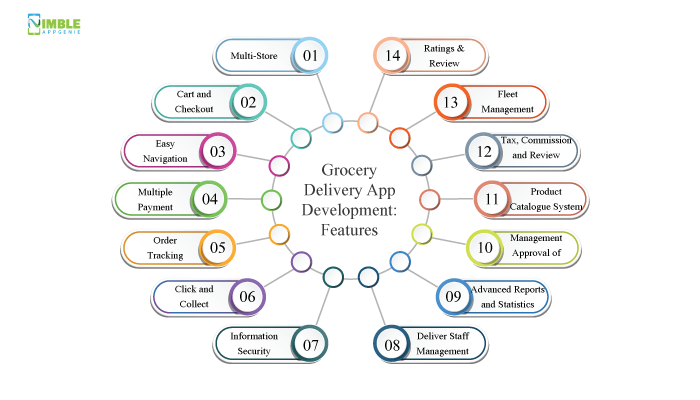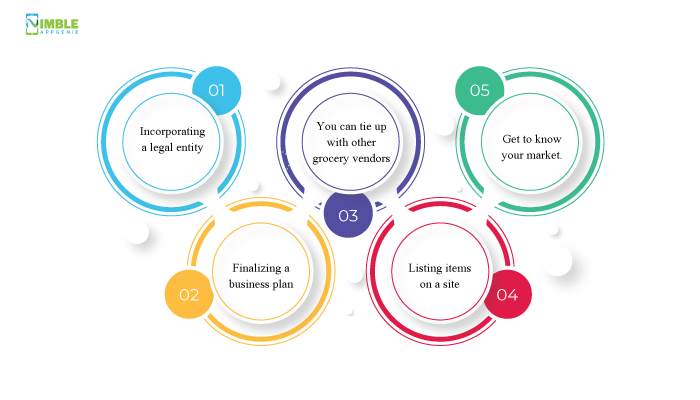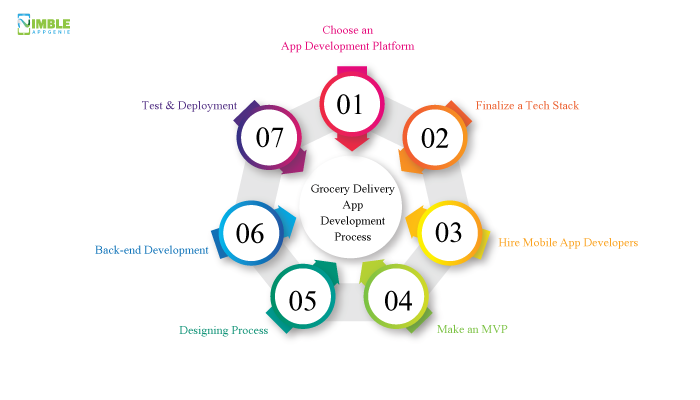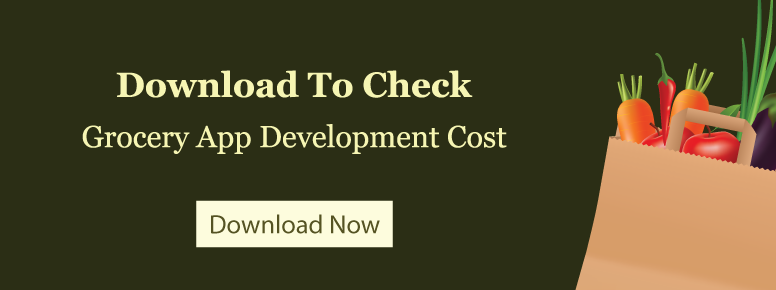Start A Grocery Delivery Business Today!
Food and beverage retail e-commerce revenue crossed more than 15 billion U.S. dollars in 2020 and is expected to cross the 24 billion threshold by 2023. In addition to this, In 2019, 81% of grocery shoppers never shopped for groceries online, but during the pandemic nearly 79% of shoppers did.
And if this wasn’t proof enough of the industry’s potential, the rate of growth in online grocery sales in the US in 2019 was 22%, which increased to over 40% in 2020.
Plus, according to a report from Brick Meets Click and Mercatus—in the US alone, online grocery sales reached over $7 billion in June. And the numbers have been growing ever since reaching $9.3 billion in March 2021.
It goes without saying that this has attracted a lot of businesses from across the United States of America to consult a grocery delivery app development company and start their own grocery delivery business.
Why start a grocery delivery business?
As major players like Amazon and Walmart enter the online grocery delivery market, the online grocery delivery industry is growing. To keep their customers happy, small and medium grocers must now join the digitalization wave as people settle down and start families and the demand for grocery delivery increases. Take a look at some interesting trends in grocery delivery across the globe.
The USA has been at the forefront of all innovations and developments that have occurred around the globe. In 2019, the USA saw a 3x increase in online grocery delivery. Another report predicts that 70% of US grocery shoppers will order online by 2022. According to a report, online grocery delivery will grow from 30% to 60% by 2024-25.
Canada is a more laid-back country than the USA. In the next few years, the market for online grocery delivery in Toronto and Vancouver is expected to grow from a $2 billion industry to a staggering $4 billion industry.
The demand for online groceries will increase as Canadians become more mobile and less reliant on in-store shopping.
Different Types of Grocery Delivery Apps
This is why many businesses are interested in grocery delivery app development. This is why you should consider doing the same. Here are a few options for those who want to create their grocery app.
1. Marketplace Grocery Delivery App
The marketplace grocery delivery app is very popular. This is because a dedicated team is responsible for delivering groceries to the customers.
This solution is for “App Owners” who provide the ordered items from their partnered stores.
2. Single Store Grocery Delivery App
This type of grocery delivery app was specifically designed to serve a single store, as the name implies. This app allows them to manage their store more effectively. Store owners often use this type of product.
3. Grocery Chain App
It is very similar to the one we previously discussed, i.e. The single-store one. What if you own more than one store? Or if there is a whole chain? This is the app you need.
Grocery Delivery App Development: Features

Features are the driving force of any project, including grocery delivery app development.
Now, if you are someone who wants to create a market leading app, these are some of the leading features that you can include in your app to start a grocery delivery business.
With that being said, let’s look at some of the basic features of the app.
1] Multi-store
Customers will appreciate the convenience of having multiple locations. You can also earn different commission rates with each vendor. Your business will benefit from a greater number of vendors.
2] Cart and Checkout
These pages are essential for any eCommerce mobile app development project. Customers must easily transition from the cart page to the checkout page. They will buy faster if they can move quickly.
3] Easy Navigation
A great user experience is built around easy navigation. It should be easy to get from A to B. That is something all of us can agree on.
4] Multiple Payment Options
An online grocery delivery service provider, or any ecommerce store, must offer multiple payment options to consumers. This will make it easier for them to order.
5] Order Tracking
People love to be kept informed about their orders at all times. You’ll get more satisfied customers if you keep them updated.
6] Click and Collect
Many grocery delivery companies have realized the benefits of Click and Collect, which allows them to combine online and in-store shopping. This omnichannel strategy allows customers to order groceries online and then pick them up at a store or common point.
7] Information Security
Customers trust you to protect their data and keep it safe when they share it with you. Protecting sensitive information like credit card numbers and personal information is important.
8] Delivery Staff Management
The platform should allow for efficient delivery management and allocation between drivers.
9] Advanced Reports and Statistics
Administrators must be able to manage online grocery sales and delivery operations. They should have an informative dashboard that displays key numbers to help them make informed business decisions.
10] Management Approval of Sellers
The platform admin should manage approvals for sellers to join the multivendor platform. Vendors must register with their details to become sellers registered on the marketplace.
11] Product Catalogue System
A defined system can help you manage a clear and complete product catalogue. This will increase the market’s value. The system will allow for systematic entries to ensure customers easily understand all information.
12] Tax, Commission, and Revenue Management
The tax, commission, and revenue management for online grocery delivery platforms must be properly ordered and compliant. Administrators should be able to manage all accounts through the platform’s software.
13] Fleet Management
Fleet management provides reports and analytics that help managers assess fuel consumption along the route. It can also identify drivers who drive more than necessary on a route.
14] Ratings and Reviews
Groceries delivery businesses need to improve merchant credibility and increase conversions. This can be achieved by rating and reviewing, as well as increasing customer engagement and monitoring customer service efforts.
How Does Grocery Delivery App Business Make Money?
The main goal of any mobile app development is to generate revenue. In this section of the blog, we shall be looking at different monetization strategies that you can incorporate into your grocery delivery app to generate sky-rocketing revenue. So with this being said, let’s get right into it:
1. Commission on Transactions
This commission is charged to the seller/vendor for every sale made on the marketplace platform. The marketplace owner will earn based on the number of sales that occur on their platform.
2. Delivery Commission
This commission model charges both the buyer and driver a certain amount for their purchase and delivery. The money is credited to the account of the marketplace owner whenever an order has been placed.
3. Vendor Subscription fees
Also known as membership fees, this revenue model can be used to bring in vendors that aren’t comfortable with the commission model. They will pay a fixed subscription fee. These vendors can access your services for a set period (quarterly, bi-annually, annually, etc.).
4. Banner ads and on-site promotions
The marketplace platform allows vendors to post customized ads via banners or schemes on the website. This is a great way to generate revenue. The admin can charge sellers for the space they need and the number of campaigns they wish to run.
Things to Do Before You Hire Grocery Delivery App Developers

There are things you need to do before build grocery delivery app. In this section of the blog, we shall be discussing these things. So, therefore, with this being said, let’s get right into:
· Incorporating a legal entity
Registering a company with an authorized registration authority is the first step in establishing a business. Online grocery sales will require you to pay sales tax.
· Finalizing a business plan
A grocery delivery service that delivers groceries online involves ordering from a vendor, picking it up and delivering it to the consumer. There are many ways that an on-demand grocery delivery model can work.
· You can tie up with other grocery vendors.
This model allows you to tie up with local grocery vendors that don’t offer delivery online. An online grocery marketplace will be created that lists all vendors within a particular area. Your marketplace will allow consumers to find the nearest vendor to their location and deliver the items directly to their homes.
· Listing items on a site
This service model allows you to list different grocery items online. Customers can then choose which item they want and how many. These items will be purchased from a vendor and delivered to your customers. This is something that you need to do before you hire grocery delivery app developers.
· Get to know your market
Your customers are the best way to target your market. Is your grocery service focused on people who can’t shop in-store, or can you cater to professionals, working families, and others?
Your market might be limited to a specific area or multiple areas. These areas could be rural, urban, suburban, or a combination. Knowing your target market, you can highlight certain items on your website that are most relevant to a particular demographic.
Develop Grocery Delivery App: Grocery Delivery App Development Process

Now that all the preparations are done, it is time to start the technical process. We shall be hiring the developers to start the development process. Therefore, let’s look at the development process, it is, as mentioned below:
1. Choose an App Development Platform
First, choose a platform for mobile app development.
You have two options: Android and iPhone app development services. These are the main platforms, and which one is best for you depends on your requirements as well as your personal preferences.
You can also choose React Native App Development Services for Cross Platform App Development, which gives you the best web and platform.
Once you’re done, we can move on to the next step by selecting the tech stack.
2. Finalize a Tech Stack
The tech stack is the collection of technologies used to create an app or start a grocery delivery company. This includes frameworks, programming languages, toolkits, etc. MEAN Stack Development is a popular example.
3. Hire Mobile App Developers
Once everything is done, you can hire dedicated developers to make your app a reality.
Here are some things to keep in mind. They are:
- Their portfolio
- Technical expertise
- Experience
- Communication
- Size of the team
You need to keep these things in mind as you hire mobile app developers.
4. Make an MVP
Before you begin the final stage of development, it is a good idea for MVP to be created. The app design company will create a prototype that is bare-bone and “minimum viable product”.
5. Designing Process
Here are all the features and designs for the grocery delivery app. To create an appealing design, market-leading UX/UI Designers are available to you.
We have discussed the features included in the same. We will now move to the back-end development.
6. Back-end Development
This is where on-demand app development will write the application’s source code. Plus, this is the most difficult and longest process. This is why it’s important to communicate well with the development side.
7. Test & Deployment
After the app has been developed, it must be tested for bugs and errors.
It all depends on whether you hire iPhone app developers or your own.
What Does it Cost to Build a Grocery Delivery App?
Mobile application development cost is highly dependent on many factors. These are some of the factors which we have listed below:
- App Development Platform
- App Support & Maintenance
- Tech Stack
- Approximate Size
- Type of solution
These are just a few variables that can affect the development cost. However, the development cost can range between $15,000 and $35,000.
It is recommended to consult an on-demand app development company for more information.
Conclusion
This is all you need to know about grocery delivery app development and how to start a grocery delivery business of your own, now, if you are someone who wants to know more about it, you should contact a mobile app development company who can help you with the same.

Niketan Sharma is the CTO of Nimble AppGenie, a prominent website and mobile app development company in the USA that is delivering excellence with a commitment to boosting business growth & maximizing customer satisfaction. He is a highly motivated individual who helps SMEs and startups grow in this dynamic market with the latest technology and innovation.
Table of Contents














No Comments
Comments are closed.